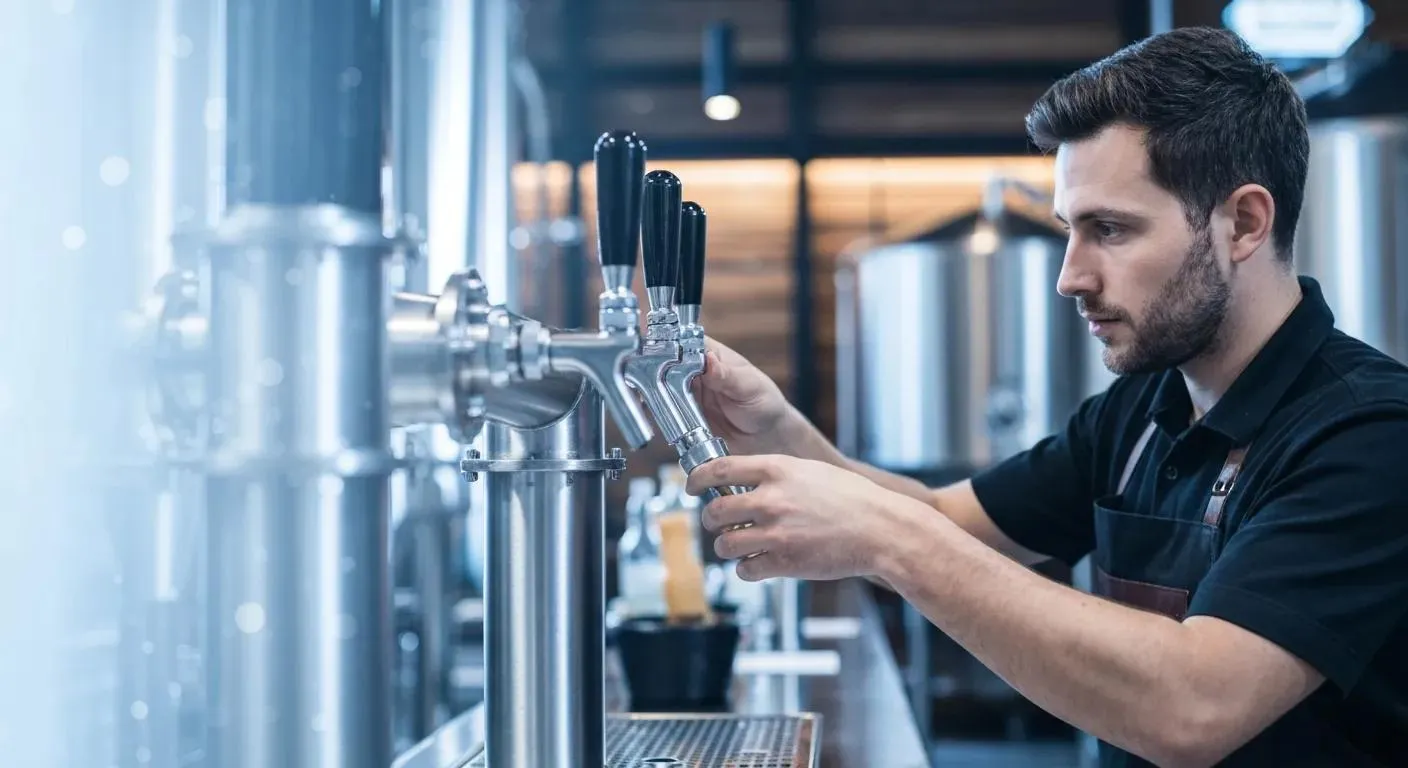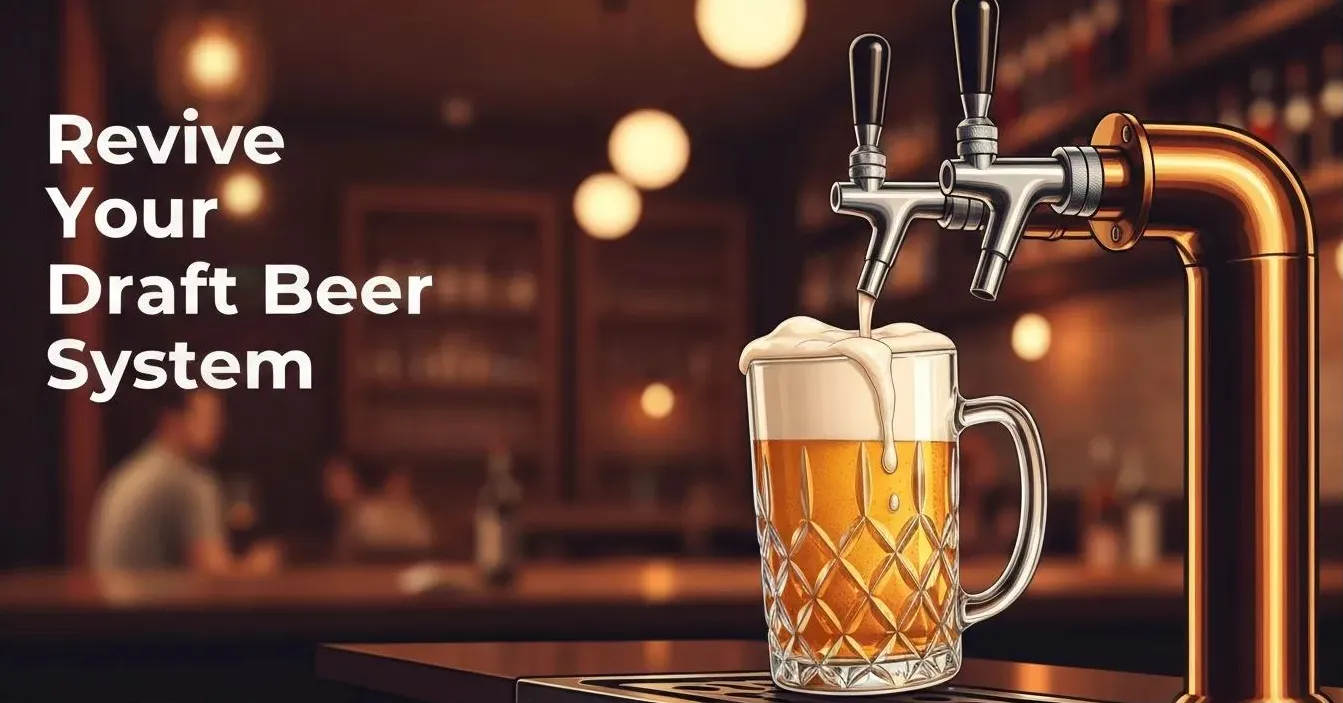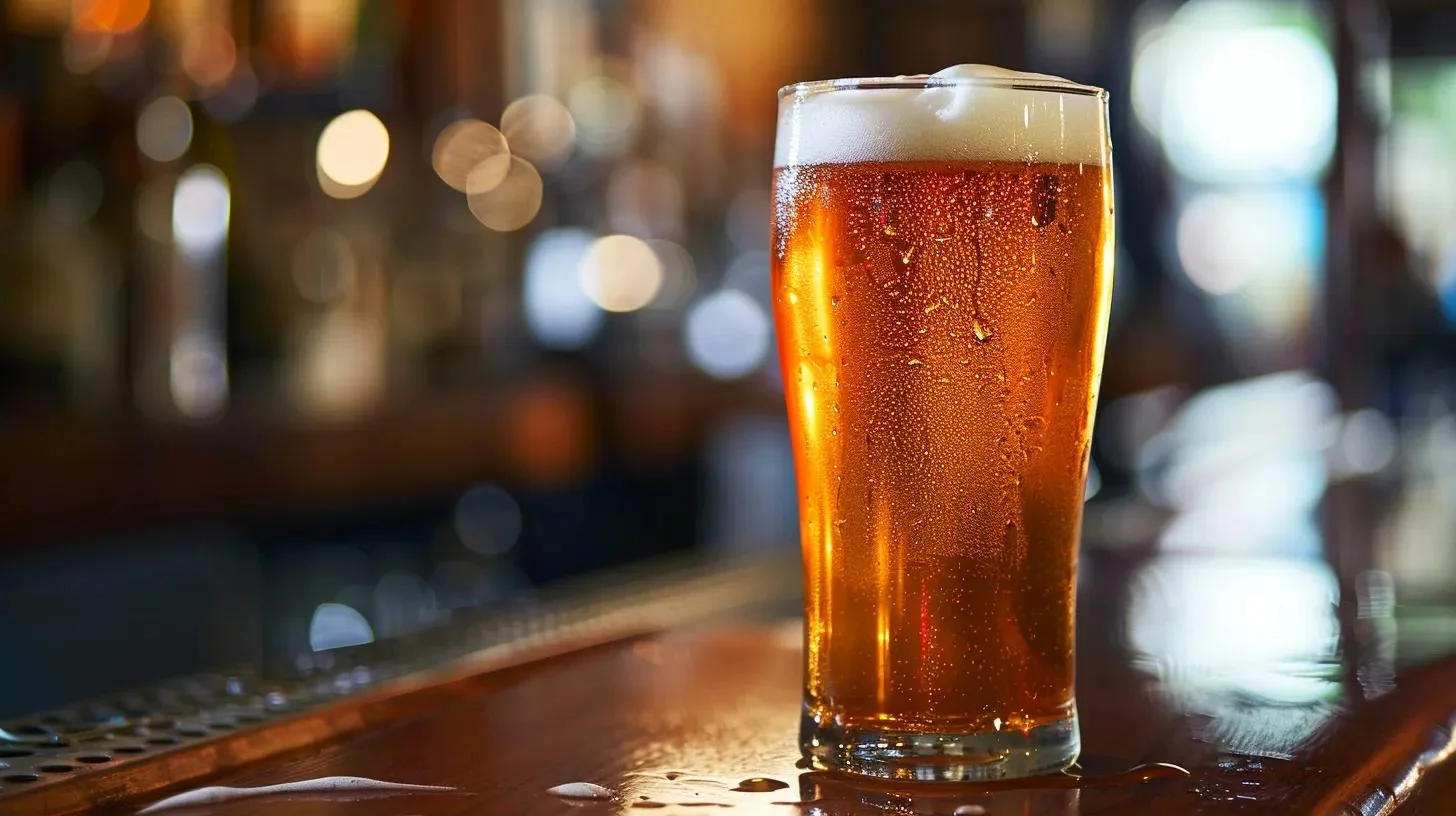How to Balance a Beer Draft System: A Clear and Confident Guide

Balancing a beer draft system is a crucial step in ensuring that the beer you serve is of high quality. If the system is not balanced, you may end up with either too much foam or flat beer. This can be frustrating for both the brewer and the owner.To balance a beer draft system, you need to consider several factors, including the temperature of the beer, the pressure of the CO2, and the length and diameter of the beer lines. These factors work together to ensure that the beer is carbonated properly and poured at the right temperature.Balancing a beer draft system can be a complex process, but it is essential for the bar owner who wants to serve high-quality beer. In the following sections, we will explore the various factors that contribute to a balanced beer draft system and provide tips on how to achieve the perfect pour.
Understanding Beer Draft Systems
A beer draft system is a system that dispenses draft beer from a keg to a tap. The system works by applying CO2 pressure to the keg, which forces the beer out of the keg and through a beer line to the tap. There are different types of beer draft systems, including direct draw systems, remote, and air-cooled systems.
Direct-Draw Draft System
A direct-draw draft system is a type of beer draft system that is commonly used in bars and restaurants. In this draft system, however, the kegs are stored in a cooler/kegerator. The beer is then dispensed through a tap that is mounted on a cooler wall or kegerator beer tower. The beer line runs from the keg to the tap, and the CO2 pressure is applied directly to the keg.

Remote/Glycol System
A remote system is another type of beer draft system that is commonly used in bars and restaurants. In this system, the kegs are stored in a refrigerated room or a full walk in cooler back-in cooler. The cold beer is then dispensed through a tap after traveling a distance through a beer trunk line. When the beer leaves the cooler it is kept cool with the help of a glycol power pack. The distance beer can be poured with this system can range from 10'-800'.

Balancing the Draft System
Balancing a draft beer system is crucial to ensure that the beer served is carbonated and has the right amount of foam. There are several factors to consider when balancing a cold draft beer system, including carbonation and pressure, temperature, beer line length, equipment restriction value, rise/fall, and altitude.
Carbonation and Pressure
Carbonation is the process of dissolving carbon dioxide in beer to create bubbles that give it a refreshing fizz. The carbonation level of beer varies depending on the style and can range from 1 to 4.0 volumes of CO2 per volume of beer. The carbonation level determines the amount of gas pressure required to maintain it.
Temperature and Beer Line Length
Temperature plays a crucial role in maintaining the carbonation level of beer. The cooler temperature colder the beer, the cooler the more CO2 it can hold. The ideal temperature for most beers is 38°F.Beer line length is also a critical factor in balancing a draft system. The length of the beer line determines the amount of resistance that the beer encounters as it flows through the line. The resistance is influenced by the diameter of the line, the material used, and the run length.
To balance a draft system, it is essential to consider all of these factors and make adjustments as necessary. A balanced draft system ensures that the beer is carbonated correctly, has the right amount of foam, and is served at the ideal temperature.
Understanding Different Styles of Beer
When it comes to balancing a beer draft system, it's important to understand the different styles of beer that you'll be serving. Each style has its own unique characteristics that can affect the balance of the system. Here are some of the most common styles of beer:
Ales
Ales are a type of beer that is fermented at a higher temperature than lagers, which gives them a fruity and sometimes spicy flavor. They tend to be more complex than lagers, with a range of flavors that can include everything from caramel and toffee to chocolate and coffee.
Ambers
Ambers are a type of ale that is known for their reddish-brown color and their balanced flavor. They are typically brewed with a combination of malted barley and caramel malt, which gives them a slightly sweet and nutty flavor.
Stouts
Stouts are a type of beer that are known for their dark color and rich, roasted flavor. They are typically brewed with roasted barley, which gives them a slightly bitter flavor that is balanced by a creamy, smooth texture.
Guinness
Guinness is a type of stout that is brewed in Ireland and is known for its creamy texture and rich flavor. It is typically served on nitrogen rather than carbon dioxide, which gives it a unique texture and mouthfeel.When balancing a beer draft system, it's important to consider the characteristics of each style of beer that you'll be serving. This includes the carbonation level, the temperature, and the pressure at which the beer is served. By understanding these factors, you can ensure that your draft system is properly balanced and that your customers are getting the best possible experience.
Carbon Dioxide and Nitrogen in Draft Systems
Draft beer systems use carbon dioxide (CO2) and nitrogen (N2) to push beer from the keg to the tap. CO2 is the primary gas used in most draft beer dispensing systems, while nitrogen is typically used for creamy, low-carbonation beers like stouts and porters.

CO2 is stored in high-pressure tanks and is used to carbonate and push the beer out of the keg. The pressure of the CO2 is regulated by a CO2 regulator, which reduces the pressure from the tank to a level that is safe and effective for dispensing beer. The regulator is connected to the CO2 tank on one end and usually connects to secondary regulators on the other end.
Nitrogen is also stored in high-pressure tanks and is used to push beer through the keg and out of the tap. Nitrogen is typically used for beers that require a creamy texture and low carbonation, like stouts and porters. Nitrogen is regulated by a nitrogen regulator, which works in the same way as a CO2 regulator.It is important to note that CO2 and nitrogen regulators are not interchangeable. The regulator used for CO2 cannot be used for nitrogen and vice versa.
In summary, CO2 and nitrogen are essential gases used in draft beer systems. CO2 is the primary gas used to carbonate and push the beer out of the keg, while nitrogen is used for low-carbonation, creamy beers. It is important to use the correct regulator for each gas to ensure safe and effective dispensing of the draft beer system.
Dealing with Foam and Temperature
When it comes to balancing a beer draft system, dealing with foam and temperature is essential. Foam is a common issue in draft beer systems that can be caused by several factors, including the wrong restriction value, wrong beer line, wrong temperature, and wrong applied pressure. To prevent foaming, it is important to ensure that the beer is dispensed at the right temperature and pressure.
Temperature is the most critical factor that affects beer foaming. Beer should be dispensed at a temperature between 36 and 38 degrees Fahrenheit. If the beer is warmer than this, foaming is likely to occur, unless additional restriction is used or the beer is carbonated to a lower level. It is important to note that beer line temperature also plays a crucial role in preventing foaming. If cold temperature of the beer line is too cold air too warm, the beer will foam excessively.
To ensure that the beer is dispensed at the right temperature, it is recommended to use a thermometer. A thermometer can be used to regulate the temperature of the beer as it is dispensed. It is also important to keep the cold beer lines and faucets clean to prevent contamination, which can cause foaming.

Another way to prevent foaming is to ensure that the applied pressure is correct. The gas pressure should be equal to the restriction value. If the gas pressure is too high, the beer will foam excessively. On the other hand, if the gas pressure is too low, the beer will be flat and lack carbonation.
In summary, dealing with foam and temperature is crucial when balancing a beer draft system. To prevent foaming, it is important to dispense the beer at the right temperature, ensure that the beer lines are clean, and use a thermometer to check the temperature at the faucet and in the cooler if necessary. Additionally, it is important to ensure that the applied pressure and beer system is correct to prevent excessive foaming or flat beer.
Advanced Topics in Draft Systems
For those looking to take their draft system to the next level, there are several advanced topics to consider. Here are some key concepts to keep in mind:
Restriction Value and Flow Rate
When designing a draft system, it's important to consider the restriction value and flow rate of the system. The restriction value is the amount of resistance the beer encounters as it flows through the system, while the flow rate is the speed at which the beer flows. A system with too much restriction will cause the beer to pour slowly, while a system with too little restriction will cause the beer to pour too quickly and result in foaming. We are aiming for a flow rate of 2 oz per second.
Keg Pressure and Restriction Pressure
The keg pressure is the amount of pressure required to push the beer out of the keg and through the system, while the restriction pressure is the amount of pressure required to overcome the restriction value the draft beer system. It's important to balance these pressures to ensure a smooth pour and the perfect pint.
Volumes of CO2
The volumes of CO2 in the beer will also affect the pour and the overall taste of the beer. Different beer styles require different levels of carbonation, and it's important to adjust the system accordingly. The Brewers Association Draught Beer Quality Manual is a great resource for determining the appropriate levels of carbonation for different beer styles. When we are pouring most beers we use 2.5 units of carb for most ales and lagers. For Nitrogenated beers like Guinness it's important to use the right Nitro blend or Guinness gas and the appropriate equipment to dispense Nitro products.
Equilibrium
Achieving equilibrium in a draft system is key to maintaining a consistent pour. This means that the pressure in the keg, the pressure in the system, and the carbonation level of the keg beer are all in balance. Once equilibrium is achieved, the system should pour smoothly and consistently.
Secondary Regulators
For those looking to serve multiple beers from kegs on the same system, secondary regulators are a useful tool. These regulators allow for different pressures to be applied to different kegs, ensuring that each beer is poured at the appropriate pressure and carbonation level.
By considering these advanced topics, draft system owners can ensure that their system is properly balanced and pouring the perfect pint every time.Enter your text here...

Further Discussions and Resources
For those who want to dive deeper into the topic of balancing a beer draft system, there are many resources available. Online forums and discussion boards can be a great place to ask questions and get advice from experienced homebrewers and beer enthusiasts. Websites such as HomeBrewTalk and BeerAdvocate have active communities that are happy to help answer questions and share their knowledge. One go to resource is the Draught Quality Manual from the Brewers Association.
In addition to these resources, there are also a number of books and manuals available on the subject of draft beer systems and homebrewing. These resources can provide more in-depth information on the science behind balancing a draft beer system, and offer tips and tricks for achieving the perfect pour.
Frequently Asked Questions
What should the CO2 setting be for draft beer?
The CO2 setting for draft beer depends on the type of beer, temperature, and altitude. In general, most beers require a CO2 pressure of 12-14 psi. However, some beers may require higher or lower pressure. It is important to consult the beer's manufacturer or distributor for the recommended CO2 pressure.
How can you calculate beer line restriction?
The total System Restriction Value is the resistance the beer encounters as it flows through the beer system. To calculate the restriction value, you need to know the length of the beer trunkline, diameter, rise/fall, and restriction value of the beer tower being used. The formula for calculating:


Blended Gas Chart.TSRV= Beer Line I.D X Length of the Beer Trunk Line +/- Rise and Fall of the Run + Restriction Value:For Example, let's say we have a Beer Run Length of 150' and we are using 3/8 I.D Beer Trunk line from Micro Matic. The restriction value of Barrier tubing 3/8 Line is .06 lbs of restriction. So .06 X 150=9 lbs of restriction.For the rise/fall portion of our equation know that if the beer travels up 12' and down 12' there is no rise and fall they cancel each other out. We are talking if a beer cooler is downstairs and the beer towers are upstairs 12' above we would say the beer run rises 12'. In this case, we would take the 12' divide by two. This gives us 6 lbs of added restriction. Now if the run was 12' below it would be -6 lbs of restriction and we would subtract that from the 9 lbs we got from the beer trunk line run length.
The last part we need is the restriction value of our beer tower. Most beer towers from Micromatic use 7.5 lbs of restriction so we will assume this. So 9+6+7.5= 22.5.So we would need an applied pressure of 23 lbs for our beer system. Now C02 wouldn't work because we would over-carbonate the beer we are trying to pour so we would need a blended gas to pour this beer. A blended gas of 70/30 mix of C02 to Nitrogen would work great.
For Longer runs a different blend may be required to achieve the greater run distance or multiple floor distance. Check the Draught Quality Manual for Line restriction values for different sized I.D. and Line material.
Conclusion
Balancing a beer draft system is a crucial step to ensure that the beer tastes great and has the right amount of carbonation. It involves determining the proper carbonation level, serving the correct temperature throughout, and identifying the appropriate pressure to set the regulator to deliver.
By following the steps outlined in this article, beer enthusiasts can achieve the perfect balance for multiple beer lines in their home draft system. It is important to remember that the process of balancing a draft system requires patience and attention to detail.
Some key takeaways from this article include:
- The carbonation level of beer varies depending on the style, but a good, all-purpose number is 2.5
- The appropriate pressure to set the regulator to deliver depends on the carbonation level and serving temperature of the beer.
Overall, balancing a beer draft system is an essential step to ensure that the beer tastes great and has the right amount of carbonation. With a little bit of patience and attention to detail.



